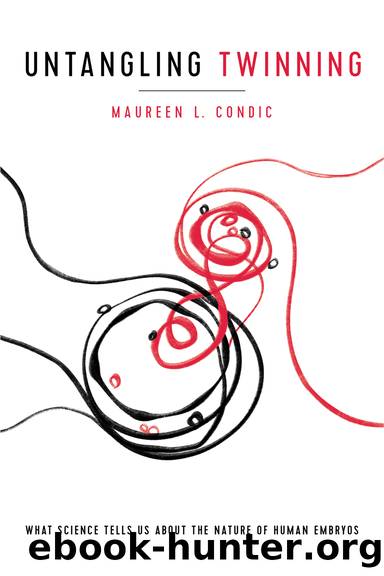Untangling Twinning by Maureen L. Condic

Author:Maureen L. Condic
Language: eng
Format: epub
Publisher: University of Notre Dame Press
Published: 2020-02-03T00:00:00+00:00
Ethical and Legal Status of “Preembryos”
The Aristotelian view that a human substantial form causes all the acts of the embryo and exists from the very beginning of life is by no means universally accepted. While some view embryos as immature human beings,12 others consider them to be merely “potential” human beings, worthy of consideration but not of full human rights.13 Importantly, the debate over the status of the human embryo is not merely academic. The advent of modern assisted reproductive technologies has brought human embryos to the attention of the legal system. Excess, frozen embryos produced by fertility clinics have frequently become the subject of litigation between the parents who created them. In some cases, courts have viewed such embryos primarily as property and judged that destroying them can be warranted to prevent forced procreation.14 In other cases, courts have either viewed embryos as human beings15 or concluded precisely the opposite.16 In these situations, the term “preembryo” is often invoked to distinguish the limited consideration due to early human embryos, compared to later embryonic and fetal stages. For example, in 2005, Judge Kessler stated in Jeter v. Arizona, “Current scientific knowledge concerning embryonic development underscores the difference between a viable fetus in vivo and an eight-cell, three-day-old pre-embryo in vitro.”17
The term “preembryos” and the distinction it purports to make have clearly not been adopted by the scientific community. A query of PubMed, the world’s largest database of scientific publications, returns only 395 papers using the term “preembryo” over the last four decades, with many of these works being ethical commentaries rather than scientific research.[18] In contrast, the standard scientific terms used to describe the period of development Grobstein rechristened “preembryonic” (i.e., zygote, preimplantation embryo, morula, blastocyst) were used 36,435 times over the same period.[19] Yet even though “preembryo” is not an accepted scientific concept, the term is widely employed outside of the scientific profession. A recent search of the LexisNexis database of legal and business publications returned over 1,200 citations using the term “preembryo,” including more than 200 from the last five years alone.[20] Given the range of opinions regarding the ethical and legal status of early human embryos and the significance of the issues that turn on these opinions, it is important to revisit Clifford Grobstein’s argument in favor of the term “preembryo” in light of the scientific evidence and scientific reasoning presented here.
As noted in the introduction, in an article entitled “Biological Characteristics of the Preembryo,” published in 1988,21 Grobstein made a number of arguments in support of the claim that human embryos do not exist until formation of the primitive streak (approximately fourteen days following sperm-egg fusion). Grobstein’s strongest argument is based on “individuation.” He holds that because “preembryos” can be both split and fused (i.e., because monozygotic twinning and chimera formation are possible), early embryos lack “developmental individuality” and consequently “would not develop into an integrated and single adult.”22
Yet this is patently false. It is a simple matter of fact that the vast majority of embryos that survive to live birth (greater than 99.
Download
This site does not store any files on its server. We only index and link to content provided by other sites. Please contact the content providers to delete copyright contents if any and email us, we'll remove relevant links or contents immediately.
When Breath Becomes Air by Paul Kalanithi(7264)
Why We Sleep: Unlocking the Power of Sleep and Dreams by Matthew Walker(5642)
Paper Towns by Green John(4169)
The Immortal Life of Henrietta Lacks by Rebecca Skloot(3826)
The Sports Rules Book by Human Kinetics(3588)
Dynamic Alignment Through Imagery by Eric Franklin(3489)
ACSM's Complete Guide to Fitness & Health by ACSM(3469)
Kaplan MCAT Organic Chemistry Review: Created for MCAT 2015 (Kaplan Test Prep) by Kaplan(3423)
Introduction to Kinesiology by Shirl J. Hoffman(3301)
Livewired by David Eagleman(3123)
The River of Consciousness by Oliver Sacks(2992)
Alchemy and Alchemists by C. J. S. Thompson(2912)
The Death of the Heart by Elizabeth Bowen(2901)
Descartes' Error by Antonio Damasio(2732)
Bad Pharma by Ben Goldacre(2730)
Kaplan MCAT Behavioral Sciences Review: Created for MCAT 2015 (Kaplan Test Prep) by Kaplan(2492)
The Gene: An Intimate History by Siddhartha Mukherjee(2491)
The Fate of Rome: Climate, Disease, and the End of an Empire (The Princeton History of the Ancient World) by Kyle Harper(2436)
The Emperor of All Maladies: A Biography of Cancer by Siddhartha Mukherjee(2431)
